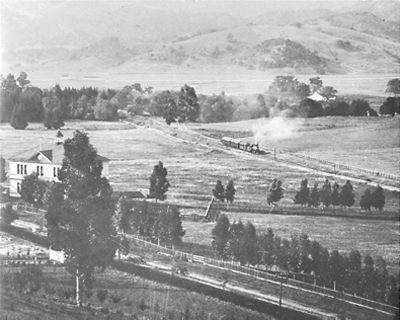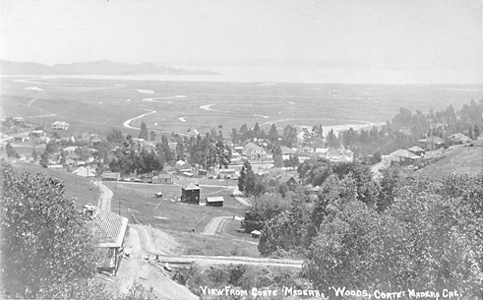
Marin County - Our Towns - Corte Madera

Marin County - Our Towns - Corte Madera
CORTE MADERA-----------------------------------Moving freightThis has always been a town of commerce, a place to ship or swap all kinds of goodsBY MATTHEW STAFFORD |
 Corte Madera Heritage and History GroupThe steam train heading south, circa 1890, behind the old Larkspur-Corte Madera School near the present day boundary between the two towns. The road in the foreground is now Corte Madera Avenue (in Corte Madera) and Magnolia Avenue (in Larkspur). |
| In many ways Corte Madera's history parallels that of
its immediate and complementary neighbor, Larkspur. Loggers worked the same rancho (from
which the town got its name); farming and cattle raising followed. But Corte Madera was
chosen to host the first post office and the first railroad station between Sausalito and
San Rafael, and it also boasted one of the few bay harbors convenient for the loading and
unloading of cargo. Larkspur-San Francisco steamboats would stop there and load up on
Corte Madera's produce, lumber and beef for sale in the city, and San Francisco's
manufactured goods made their way to Corte Madera on the return trip. In 1848, Pennsylvanian John Van Reynegom arrived with his family at Paradise Bay, walked inland a piece and found a spot to settle in at the base of Christmas Tree Hill. As public land (between John Reed's aforementioned Rancho Corte Madera del Presidio and another belonging to Juan Cooper), the settlement was allowed to grow to some 160 acres by 1859, running east from the old railroad right-of-way to what is now Town Park, north to what eventually became the Larkspur city limits and west to the crest of Christmas Tree Hill. Van Reynegom's daughter, Amelia, had married Frank Pixley in 1853. Pixley was at various times a rancher, a T-man on the trail of opium smugglers and the publisher of the San Francisco Argonaut, a literary magazine with contributions from Mark Twain, Ambrose Bierce and Gertrude Atherton. Pixley bought his in-laws' land claim and gave it to Amelia; after Pixley's death Amelia gave an acre to the Larkspur-Corte Madera School District, kept 55 acres for herself and turned the rest over to her sister-in-law with the proviso that it be properly developed (Amelia was, among other things, the epitome of municipal boosterism). The parcel was laid out for homesites that were then sold by the Pixley children to unsuspecting Sunday excursionists as they emerged at the train station. |
|
 Corte Madera Heritage and History GroupView of old Corte Madera Square from Christmas Tree Hill, about 1910. The livery stable, now a bike shop, is to the right of center. Marshlands extend unimpeded to the bay. |
Many of these early settlers were artists attracted to the climate and the good bay views from Christmas Tree Hill, where most of them built their homes. Much of Corte Madera's summer population moved in for good after the 1906 earthquake and fire; 10 years later the town was incorporated. It remained a small, sparsely populated community of snug wooden bungalows until World War II, when thousands of shipyard workers from around the country streamed into the area to work at nearby Marinship. New residential neighborhoods of tightly packed tract houses sprang up overnight. The postwar baby boom continued the process, and the Corte Madera Shopping Center (completed in 1952) and the Paradise Shopping Center (1962) were built to accommodate the new wave of settlers. Population grew from 1,000 in 1940 to 8,200 in 1966. |
| In the late '60s, Corte Madera's largely unchecked
growth culminated with proposals for a new dumpsite along Paradise Drive and an extension
of the Paradise Shopping Center. This threat to the area's fragile marshlands inspired the
birth of Corte Madera's powerful environmental movement, which led in turn to the 1972
recall election of its mayor and two town councilmembers. The Corte Madera Ecological
Reserve, marshlands along the town's northern bayfront, is the movement's living,
breathing monument. Another is the current state of The Village shopping center. Originally conceived as a two million-square-foot complex built upon the marshlands, it opened in the mid-'80s as a half million-square-foot mall adjacent to the wetlands. It and the Corte Madera Town Center (a gussied-up descendant of the old Corte Madera Shopping Center) act as trans-highway guideposts to the new town, grandiose symbols of Corte Madera's growth since 1920, when the old town center around the train station contained all of the city's businesses: post office, fire station, general store, hotel and-real estate office. Still off to the west are the city's oldest houses, wonderful chalets and Victorians clinging to the warm side of Mt. Tam that offer its inhabitants the views beloved by Corte Madera's earliest settlers. |
|